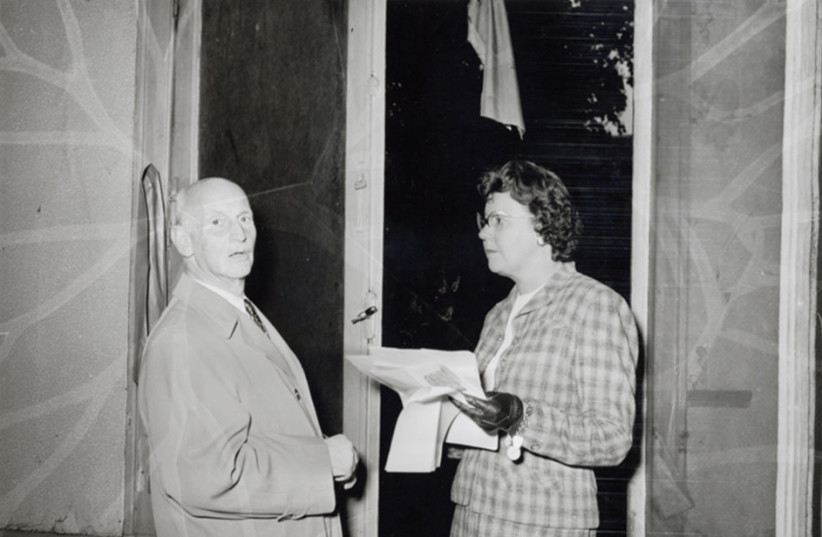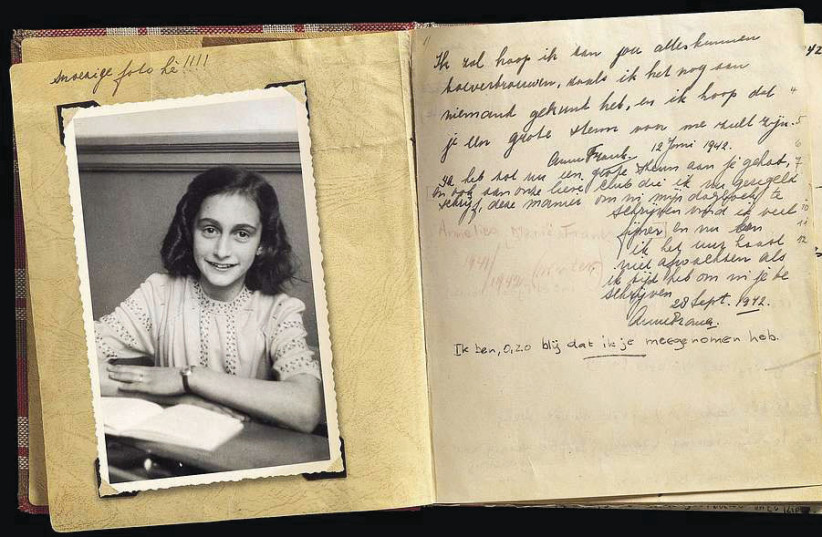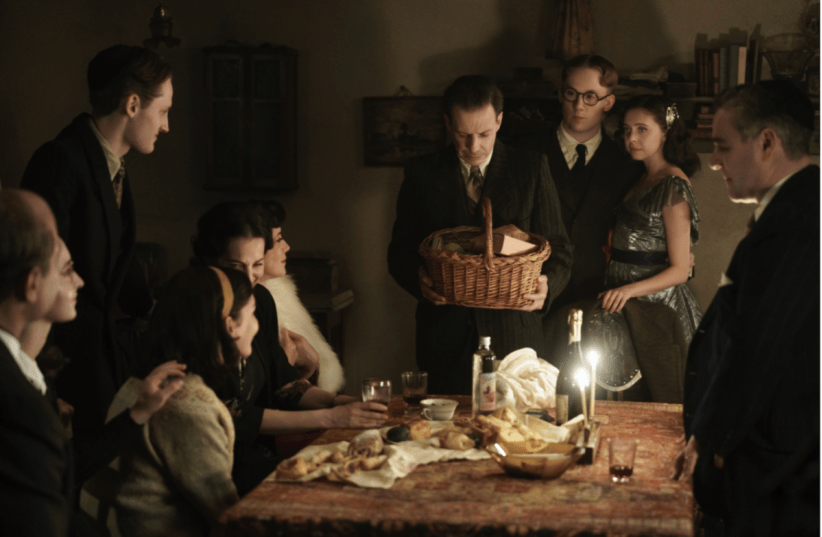Hundreds of books, films and academic studies have been created about a young Jewish girl who wrote a diary and became the face of the Holocaust for generations. According to many media outlets, after the Bible, The Diary of Anne Frank is the most widely read nonfiction book in the world. Her diary was translated into 60 languages and has been adapted hundreds of times for stage, film and television.
It isn’t easy to find a new angle about Anne Frank that no one has explored before, but two American filmmakers were able to find one and created A Small Light, a powerful, eight-episode limited series that tells the remarkable true story of 20-something secretary Miep Gies (portrayed by British actress Bel Powley). Gies didn’t hesitate when her boss, Otto Frank (portrayed by Hollywood actor Liev Schreiber, of Ray Donovan, X-Men), asked her to hide him and his family from the Nazis during World War II. The series is due to premiere this spring on the National Geographic and Disney+ channels.
For the next two years, Miep, her husband, Jan (played by Joe Cole, Skins), and several other everyday heroes watched over the eight souls hiding in the secret annex. It was Miep who found Anne Frank’s diary and preserved it so that she and Otto could later share it with the world.
A Small Light: A new Anne Frank story for Disney
A Small Light is produced by ABC Signature in partnership with Keshet Studios for National Geographic. Executive producers and writers Joan Rater and Tony Phelan (ABC’s Grey’s Anatomy and Council of Dads) serve as show runners. Phelan and Rater are husband and wife. In an interview with the Magazine, Phelan shared that “we took our kids to the Anne Frank House in Amsterdam, and we were there reading the plaques about all the helpers.”
The couple then realized that their then 20-year-old son, who had just graduated from college, was around the age of Gies. “We realized that Miep was not really that much older than he was when Otto [Frank] asked her to help fight for his family. And we looked at our son and we’re like: ‘He can’t even find his way back to the hotel,’” he laughed. “How did this young woman take on this responsibility? She and her husband had to kind of put it together as they went forward,” he said of Gies.


“We decided to start researching, so we hooked up with a Dutch researcher in Amsterdam who translated for us, and we also delved into the records in Amsterdam. We began to dig out all this really interesting information, some of which was in Miep’s book, a lot of which wasn’t.
“We discovered that her husband Jan was active in the Dutch resistance. Besides hiding the Franks and the others up in the annex, they were actively hiding and helping other people as well, which they never told the Franks about because it would have freaked them out to know that they were letting themselves be vulnerable in that way.
“One of the things that struck us when we were at the Anne Frank House was when someone there told us: ‘You’d be surprised how many young people come here, not knowing who Anne Frank is.’ That really put a chill into us because not only did we grow up with the book, but I grew up in Cleveland, a mid-sized industrial city. Many of my friends, parents or grandparents were survivors, so their stories were very much a part of my growing up. And the story of the Holocaust is very much part of my growing up and what we see in America.”
Asked about how they chose the cast for the film, among them Schreiber, who oftewn plays the villain in Hollywood movies and television series, Phelan quoted the actor himself, who during a Television Critics Association (TCA) press tour a few weeks ago, confided that he gets a lot of offers to perform in movies about the Holocaust but ‘til now had declined them.
“Personally, as a Jewish American who gets offered a lot of Holocaust stuff and generally hesitates, I feel like it’s my job to kind of reinvent that idea every time, and it gets harder and harder to do it the more you do it.”
Liev Schreiber
“Personally, as a Jewish American who gets offered a lot of Holocaust stuff and generally hesitates, I feel like it’s my job to kind of reinvent that idea every time, and it gets harder and harder to do it the more you do it,” Schreiber said of movies about the Holocaust.
The approach that he connects with is, however, “whatever you think you know about this story, or whatever you think you know about what it is to be Jewish, or what it is to be German or what it is to be Dutch, I’m going to try to figure out the opposite of that. I’m going to try to figure out something you haven’t seen yet.”
Schreiber said that he thinks what has been done with this movie is “extraordinary.” He elaborated that “this is not the Anne Frank story you were taught in elementary school. They’ve [Phelan and Rater] found nuance in this. If being Jewish is what you are concerned with, it gives you a broader perspective on what it is to be Jewish.”
As a Jew, Schreiber also said that he identified with his character, Anne Frank’s father, since “he felt shackled by the term ‘Jew.’ He wanted to be a German, and he couldn’t because he could only be, in this administration’s eyes, a Jew, which is a broader perspective on the Jewish conversation at large.”
Schreiber connected to Phelan’s view that he connected to this story “because it’s Miep’s perspective. She wasn’t a Jew. This was, kind of, the gift of the goy [a non-Jew]. I thought that that was a very powerful argument against antisemitism because her commitment was one of friendship, loyalty, kindness and compassion.”
POWLEY Plays Miep, a charismatic and lovable actress who, from a sneak preview of the series, seems to have totally adapted herself to the out-of-the-box thinking of Gies. Asked about the casting of Powley, Phelan explained that Gies was a little over five feet tall and that “she talked a lot about the fact that people were always underestimating her, kind of looking past her because she was a woman and she was small.
“But she was a powerhouse. She was a force of nature. In fact, many people who knew her referred to her as a pain in the ass, which I’m sure she was as well,” he laughed.
However, these unique traits, he said, “really served her, certainly when the Nazis discovered the Franks and the others in the annex.”
According to Gies’s official website, after being captured by the Nazis, she was to be deported to a concentration camp, since she was caught assisting Jews. “But then, in an incredible way, my luck turned again,” she wrote. “The Nazi who was responsible for deporting those who were hidden and their helpers was named Karl Josef Silberbauer, an arrogant and yes, Austrian man from Vienna.
“And he just wasn’t having his day, for while interrogating Otto Frank he discovered that Mr. Frank had fought for Germany in World War I and that he held a higher army rank than himself. Silberbauer didn’t quite salute him, but he did offer to do everything calmly.”
She continued: “The Austrian barked at me: ‘Are you not ashamed of yourself for helping Jews?’ I said that ‘I came from Vienna,’ just like him. Silberbauer hesitated and stomped through the room. Finally, he decided that I was allowed to stay in the office, ‘out of personal sympathy,’ he said. But he added that he would be coming back and warned me that fleeing was not an option.”
Phelan explained that “the only reason she was not arrested as well is that they thought she was a woman, and she wasn’t worth it. And because she managed to forge this connection with this SS officer. She recognized his accent and was able to forge that kind of him having to see her as a human being.”
During the TCA panel, Powley shared that she found Gies’s character “incredibly relatable as a young woman. I’m not by any means saying I’ve ever done anything nearly as heroic as that. But before she was put in that situation, or before she made the decision to do that, she was just a normal young girl. She was a party girl. She loved dancing.


“She talks in her book about all of those things, like going out with her friends, and how attractive she found her husband. She was a frivolous, fiercely independent young woman, and I related to all of those attributes about her.”
She also shared, during the panel, her thoughts about Anne as a young girl who had to hide. “I can tell you, having been a 13-, 14, and 15-year-old [girl], it is the most intense time as a young woman. It’s when you are coming of age. It’s when you are turning from a girl to a woman. You are starting to think about liking boys or whatever. I think Billie Boullet, who plays Anne, portrays that so perfectly, naturally and truthfully.”
PHELAN SAID that the filming took place in different locations in Amsterdam but also in the area of Prague in the Czech Republic. “We shot about two weeks in Amsterdam, which is notoriously difficult to shoot in because of the narrowness of the roads. It’s very difficult because we had a huge event with many trailers. So we found a way to find locations where we could shoot one scene in one direction, and another scene in a different direction,” Phelan explained.
He was exceptionally excited about the fact that they were able to shoot outside of the actual Frank apartment, “which was pretty special.” He and the cast were moved when they stood in front of the stumbling stones with the names of the family out in front of the apartment.
“We all just kind of took a moment to honor the people whose story we were telling.”
One scene shot in Amsterdam includes a group of Nazis who arrive and empty the apartment building. “When we were scouting the location, we typically go and knock on everybody’s door and say ‘This is what we’re doing,’ and because of the subject matter ‘If you feel it would be distressing [for you to see actors playing Nazis], we’ll put you up in a hotel.’
“But it turns out that there was a survivor who lived there, who at the age of four or five was smuggled out of Amsterdam in a basket on a bicycle that was used for the local bakery. He was smuggled out by the students at Amsterdam University.
I said to him, ‘Do you want to be here while I shoot this?’ And he said, ‘Absolutely.’ He has spent the latter part of his life going to schools and telling his story. So he actually gathered a couple more survivors, and they were there on the day [we filmed]. Just having him be there, to watch and to speak to the actors… It was pretty remarkable.
“One of our extras, when we were shooting in Amsterdam, said one day: ‘You know, my grandfather was a survivor.’ He never really talked about it, but he said that ‘just being a part of this has given me a little window of what some of his life must have been like, which is really gratifying.’”
THIS IS an exceptional project for Phelan and Rater, who joined Grey’s Anatomy as a writing team at the start of Season Two, and later rose through the ranks and co-ran the show alongside creator Shonda Rhimes for seasons Seven through Ten. They earned a Writers Guild of America award for best new series in television in 2005 and were nominated for two Emmy awards in 2006 and 2007 for outstanding drama series.
Since 2016, Phelan and Rater have been developing and running their own shows, including Council of Dads for NBC as well as Doubt and the upcoming season of Fire Country for CBS. They live in Pasadena with their dogs, Reggie and Lola, and “don’t see enough of their grown children, Tom and Sally,” according to Phelan.
Phelan concluded that the series title comes from something Gies said late in her life: “I don’t like being called a hero because no one should ever think you have to be special to help others. Even an ordinary secretary or a housewife or a teenager can turn on a small light in a dark room.”
